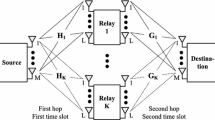Abstract
This paper derives the ergodic capacity of nonlinear MIMO–OFDM relaying communication channels. We consider MIMO–OFDM relaying system where the transmitter, relays, and the receiver are all equipped with \(N_t\) transmitting and \(N_r\) receiving antennas, and the high-power amplifiers (HPAs) at the transmitter and relays exhibit general nonlinear behaviors. We derive closed-form expressions for the ergodic capacity of the system for both the amplify-and-forward (AF) and decode-and-forward (DF) relaying protocols. Our results show that AF relaying incurs higher capacity loss due to HPA nonlinearity than the DF relaying. The results also indicate that high-order MIMO systems suffer more capacity loss due to HPA nonlinearity than low-order MIMO systems, and that more capacity loss are experienced in multihop relaying over nonlinear channels as more relay hops are involved. This analysis complements existing works in the literature, where the effects of HPA on the error rate performance of MIMO systems have been documented. It also helps to stress the need for highly linearized HPA when relaying methods of wireless transmissions are desired.







Similar content being viewed by others
References
Costa, E., & Pupolin, S. (2002). M-QAM-OFDM system performance in the presence of a nonlinear amplifier and phase noise. IEEE Transactions on Communications, 50(3), 462–472.
Sulyman, A. I., & Ibnkahla, M. (2008). Performance analysis of nonlinearly amplified M-QAM signals in MIMO channels. European Transactions on Telecommunications, 19(1), 15–22.
Qi, J., & Aissa, S. (2010). Analysis and compensation of power amplifier nonlinearity in MIMO transmit diversity systems. IEEE Transactions on Vehicular Technology, 59(6), 2921–2931.
Helaly, T., Dansereau, R., & El-Tanamy, M. (2012). BER performance of OFDM signals in the presence of nonlinear distortion due to SSPA. Wireless Personal Communications, 64(4), 749–760. doi:10.1007/s11277-010-0217-z.
Ahmad, I., Sulyman, A. I., Alsanie, A., & Alasmari, A. (2011). On the effect of amplifier non-linearity on the capacity of MIMO systems. In Proceedings of IEEE GCC confernce and exhibition (GCC) (Vol., no., pp. 108–111).
Sabbaghian, M., Sulyman, A. I., & Tarokh, V. (2013). Analysis of the impact of nonlinearity on the capacity of communication channels. IEEE Transactions on Information Theory, 59(11), 7671–7683.
Helaly, T. K., Dansereau, R. M., & El-Tanany, M. (2010). An efficient measure for nonlinear distortion severity due to HPA in downlink DS-CDMA signals. EURASIP Journal on Wireless Communications and Networking, Article ID 945427, 9.
Ahmad, I., Sulyman, A. I., Alsanie, A., Alasmari, A., & Alshebeili, S. (2013). Spectral broadening effects of high power amplifiers in MIMO-OFDM relaying channels. EURASIP Journal on Wireless Communications and Networking, 32. doi:10.1186/1687-1499-2013-32.
Peters, S. W., & Heath, R. W. (2009). The future of WiMAX: Multihop relaying with IEEE 802.16j. IEEE Communications Magazine, 47, 104–111.
Ghosh, A., Ratasuk, R., Mondal, B., Mangalvedhe, N., & Thomas, T. (2010). LTE-advanced: Next-generation wireless broadband technology [Invited Paper]. IEEE Transactions on Wireless Communications, 17(3), 10–22.
Farhadi, G., & Beaulieu, N. C. (2009). On the ergodic capacity of multi-hop wireless relaying systems. IEEE Transactions on Wireless Communications, 8(5), 2286–2291.
Sulyman, A. I., Takahara, G., Hassanein, H., & Kousa, M. (2009). Multi-hop capacity of MIMO-multiplexing relaying systems. IEEE Transactions on Wireless Communications, 8, 3095–3103.
Rowe, H. E. (1982). Memoryless nonlinearities with Gaussian inputs: Elementary results. Bell System Technical Journal, 61(7), 1519–1525.
Saleh, A. (1981). Frequency-independent and frequency-dependent nonlinear models of TWT amplifiers. IEEE Transactions on Communications, 29(11), 1715–1720.
Rapp, C. (1991). Effects of HPA nonlinearity on a 4-DPSK/OFDM signal for a digital sound broadcasting system. In: Proceedings of second European conference on satellite communiactions, Lihge, Belgium (pp. 179–184).
Bussgang, J. J. Crosscorrelation functions of amplitude-distorted Gaussian signals. Research Lab. Electron, M.I.T., Cambridge, MA, USA, Tech. Rep. 216.
Ermolova, N. Y., & Haggman, S. G. (2004). An extension of bussgang’s theory to complex-valued signals. In 6th Nordic signal processing symposium (NORSIG’04). Finland: Espoo.
Gregorio, F. H. (2007) . Analysis and compensation of nonlinear power amplifier effects in multi-antenna OFDM systems. Ph.D. dissertation, Helsinki Univ. Technol. Espoo: Finland.
Laneman, J. N., Tse, D. N. C., & Wornell, G. W. (2004). Cooperative diversity in wireless networks: Efficient protocols and outage behavior. IEEE Transactions on Information Theory, 50(12), 3062–3080.
Hyundong, S., & Hong, L. J. (2003). Capacity of multiple-antenna fading channels: Spatial fading correlation, double scattering, and keyhole. IEEE Transactions on Information Theory, 49(10), 2636–2647.
Jeffrey, A., & Hui-Hui, D. (2008). Bessel functions. In handbook of mathematical formulas and integrals. USA: Academic Press.
Gradshteyn, I. S., & Ryshik, I. M. (2000). Table of integrals, series, and products (6th ed.). New York: Academia Press.
Fritz, O. (1972). Hypergeometric functions. In M. Abramowitz & I. A. Stegun (Eds.), Handbook of mathematical functions with formulas, graphs, and mathematical tables. USA: U.S. Department of Commerce.
Acknowledgments
This work was supported by NSTIP Strategic Technologies Programs at King Saud University (number 11-ELE1854-02), in the Kingdom of Saudi Arabia.
Author information
Authors and Affiliations
Corresponding author
Appendix: Proof of Eq. (25)
Appendix: Proof of Eq. (25)
Let \(\varvec{\Omega } =\frac{P\varvec{\prod }_{i=0}^R {\beta _i \varvec{\prod }_{k=1}^R {\varvec{\Lambda }_k } } }{nN\varvec{\sigma }_{n_D }^2}\) and substituting Eqs. (25) into (24), we get the following expression:
The inner integral in (36) can be represented as \(\mathrm{T}_r \left( g \right) =\int _0^\infty {\log _2 \left( {1+g\lambda ^{m,0}} \right) } (\lambda ^{m,0})^{r}(e^{-\lambda })^{m,0}d\lambda ^{m,0}\), where \(g=\varvec{\Omega } \prod \limits _{j=1}^R {\varvec{\lambda }^{m,j}}\). The closed-form solution of this integral is given as [21–23]:
where \(Ei(a)=\int _{-\infty }^a {\frac{e^{t}}{t}dt}\) which can be approximated by [21–23]:
Using the above approximation, Eq. (37) can be simplified as
By putting Eqs. (39) into (36), we get:
Putting \(g=\Omega \prod _{j=1}^R {\lambda ^{m,j}}\) in Eq. (40) gives:
where,
The closed-form solutions of the integrals in Eq. (42)–(44) are obtained using the following expressions [21–23]:
where \(p\) is any positive integer. Now Eq. (27) is obtained by using Eqs. (45) and (46) in Eqs. (42)–(44) and then substituting Eqs. (42)–(44) in Eq. (41).
Rights and permissions
About this article
Cite this article
Ahmad, I., Sulyman, A.I., Abuhasel, K.A. et al. Ergodic Capacity of Nonlinear MIMO–OFDM Relaying Channels. Wireless Pers Commun 81, 207–224 (2015). https://doi.org/10.1007/s11277-014-2124-1
Published:
Issue Date:
DOI: https://doi.org/10.1007/s11277-014-2124-1




